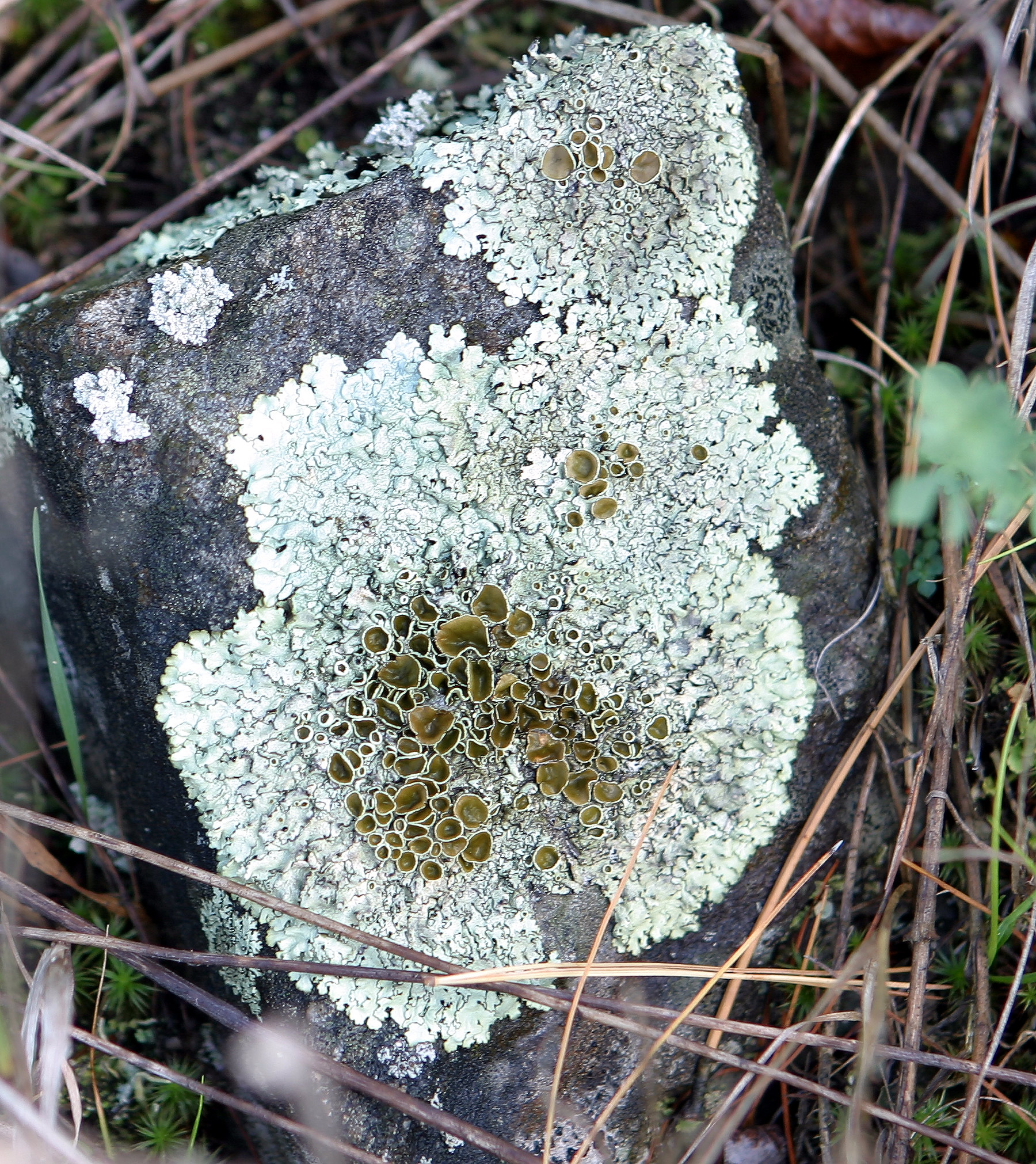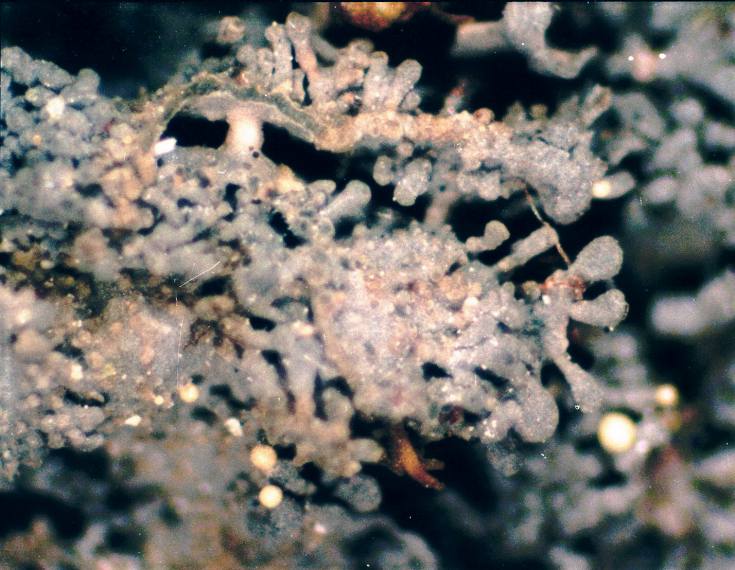|
Verrucariales
Verrucariales is an order (biology), order of Ascomycota, ascomycetous fungi within the subclass Chaetothyriomycetidae of the class Eurotiomycetes. Although most of the Verrucariales are lichenised, the family Sarcopyreniaceae consists of 11 species of lichenicolous fungi, lichenicolous (lichen-dwelling) fungi. Phylogenomics, Phylogenomic analysis suggests that the divergent evolution, divergence between the lichenised Verrucariales and nonlichenised Chaetothyriales occurred about 131 million years ago. Description Members of the Verrucariales are primarily organisms that form symbiotic relationships with algae or cyanobacteria, creating lichens. These lichens are remarkable for their ability to thrive in a wide range of environments, from extremely dry land habitats to freshwater and even marine ecosystems, where they are particularly abundant. A significant portion of Verrucariales species can be found saxicolous lichen, growing on rocks, especially in temperate climates. Some ... [...More Info...] [...Related Items...] OR: [Wikipedia] [Google] [Baidu] |
Verrucariaceae
Verrucariaceae is a family of lichens and a few non-lichenised fungi in the order Verrucariales. The lichens have a wide variety of thallus forms, from crustose (crust-like) to foliose (bushy) and squamulose (scaly). Most of them grow on land, some in freshwater and a few in the sea. Many are free-living but there are some species that are parasites on other lichens, while one marine species always lives together with a leafy green alga. Several characteristics of the spore-bearing structures, the ascomata, define the family, including their perithecioid form–more or less spherical or flask-shaped, with a single opening and otherwise completely enclosed by a wall. Squamulose members of the Verrucariaceae with simple ascospores (lacking partitions called septa), and without algae in the spore-bearing region are known as lichens; there are more than 80 of these species. The family has several dozen lichenicolous (lichen-dwelling) examples, including a few genera that co ... [...More Info...] [...Related Items...] OR: [Wikipedia] [Google] [Baidu] |
Eurotiomycetes
Eurotiomycetes is a large class of ascomycetes with cleistothecial ascocarps within the subphylum Pezizomycotina, currently containing around 3810 species according to the Catalogue of Life. It is the third largest lichenized class, with more than 1200 lichen species that are mostly bitunicate in the formation of asci. It contains most of the fungi previously known morphologically as " Plectomycetes". Systematics and phylogeny Internal relationships The class Eurotiomycetes was circumscribed in 1997 by Swedish mycologists Ove Erik Eriksson and Katarina Winka. At that time it only contained the order Eurotiales, which together with the next order added, Onygenales, form a monophyletic group comprising most of the fungi in "Plectomycetes", a group no longer in use that unified fungi under exclusively morphological characteristics. As more orders were added to Eurotiomycetes, the first two along with Arachnomycetales became constrained to the first subclass, Eurotiomycetida ... [...More Info...] [...Related Items...] OR: [Wikipedia] [Google] [Baidu] |
Adelococcaceae
The Adelococcaceae are a family of fungi in the order Verrucariales. Species are mostly found in north temperate regions, and are biotrophic or necrotrophic A fungus (: fungi , , , or ; or funguses) is any member of the group of eukaryotic organisms that includes microorganisms such as yeasts and molds, as well as the more familiar mushrooms. These organisms are classified as one of the traditi ... on lichens. The family was proposed by mycologist Dagmar Triebel in 1993. Genera * '' Adelococcus'' – 4 spp. * '' Pseudopyrenidium'' – 2 spp. * '' Sagediopsis'' – 11 spp. References Verrucariales Ascomycota families Taxa described in 1993 Lichenicolous fungi Taxa named by Dagmar Triebel {{Eurotiomycetes-stub ... [...More Info...] [...Related Items...] OR: [Wikipedia] [Google] [Baidu] |
Sarcopyreniaceae
''Sarcopyrenia'' is a genus of lichenicolous (lichen-dwelling) fungi. It has 11 species. It is the only genus in Sarcopyreniaceae, a family in the order Verrucariales. ''Sarcopyrenia'' was circumscribed by Finnish lichenologist William Nylander in 1858, with '' Sarcopyrenia gibba'' assigned as the type species. Sarcopyreniaceae is one of the few families composed entirely of lichenicolous fungi. Species Host data is from Diederich, Lawrey, and Ertz's 2018 review of lichenicolous fungi. *'' Sarcopyrenia acutispora'' – on ''Bagliettoa calciseda'' *'' Sarcopyrenia bacillosa'' – on saxicolous lichens *'' Sarcopyrenia bacillospora'' – on '' Thelidium'' and ''Verrucaria'' *'' Sarcopyrenia baetica'' – on ''Lecania'' cf. ''erysibe'' *'' Sarcopyrenia beckhausiana'' – on saxicolous lichens (mostly from family Verrucariaceae) *'' Sarcopyrenia calcarea'' *'' Sarcopyrenia cylindrospora'' – mostly on ''Aspicilia'' *'' Sarcopyrenia gibba'' – on saxicolous lichens *'' Sarc ... [...More Info...] [...Related Items...] OR: [Wikipedia] [Google] [Baidu] |
Verrucaria
''Verrucaria'' is a genus of lichenized (lichen-forming) fungi in the family Verrucariaceae. Taxonomy The genus was circumscribed by German botanist Heinrich Adolph Schrader in 1794, with '' Verrucaria rupestris'' assigned as the type species. In his brief diagnosis of the genus, Schrader mentioned the more or less spherical (''subglobose''), closed ascomata, and the crustose thallus. The genus name is derived from the Latin word ''verruca'' (meaning "wart") and the suffix ''-aria'' (meaning "belonging to" or "possession"). Ecology As of 2015, there were 16 ''Verrucaria'' species classified as marine species: '' V. adguttata'', '' V. allantoidea'', '' V. ceuthocarpa'', '' V. corallensi'', '' V. ditmarsica'', '' V. erichsenii'', '' V. halizoa'', '' V. halochlora'', '' V. microsporoides'', '' V. paulula'', '' V. psychrophila'', '' V. sandstedei'', '' V. serpuloides'', '' V. sessilis'', '' V. subdiscreta'' ... [...More Info...] [...Related Items...] OR: [Wikipedia] [Google] [Baidu] |
Lichen
A lichen ( , ) is a hybrid colony (biology), colony of algae or cyanobacteria living symbiotically among hypha, filaments of multiple fungus species, along with yeasts and bacteria embedded in the cortex or "skin", in a mutualism (biology), mutualistic relationship.Introduction to Lichens – An Alliance between Kingdoms . University of California Museum of Paleontology. . Lichens are the lifeform that first brought the term symbiosis (as ''Symbiotismus'') into biological context. Lichens have since been recognized as important actors in nutrient cycling and producers which many higher trophic feeders feed on, such as reindeer, gastropods, nematodes, mites, and springtails. Lichens have properties different from those of their component organisms. They come in man ... [...More Info...] [...Related Items...] OR: [Wikipedia] [Google] [Baidu] |
Chaetothyriomycetidae
Chaetothyriomycetidae is a subclass of ascomycete within the class Eurotiomycetes. Many species in Chaetothyriomycetidae are lichens. Morphology Chaetothyriomycetidae produce a cleistothecium through which they distribute their spore In biology, a spore is a unit of sexual reproduction, sexual (in fungi) or asexual reproduction that may be adapted for biological dispersal, dispersal and for survival, often for extended periods of time, in unfavourable conditions. Spores fo ...s. Gallery File:Exophiala phaeomuriformis.jpg File:Chromoblastomycosis 2.jpg File:Fonsecaea pedrosoi PHIL 2920 lores.jpg File:Fonsecaea pedrosoi.jpg File:Cuerpo Esclerotico.JPG File:Fonsecaea.JPG File:Phialophora verrucosa 002.jpg File:A lichen - Verrucaria mucosa - geograph.org.uk - 1055602.jpg File:Wahlenbergiella mucosa Jymm.jpg File:Verrucaria ochrostoma (Verrucariaceae), Renkum, the Netherlands.jpg File:Verrucaria muralis (Verrucariaceae), Renkum, the Netherlands.jpg File:Verrucaria macrostoma ... [...More Info...] [...Related Items...] OR: [Wikipedia] [Google] [Baidu] |
Parasitism
Parasitism is a close relationship between species, where one organism, the parasite, lives (at least some of the time) on or inside another organism, the host, causing it some harm, and is adapted structurally to this way of life. The entomologist E. O. Wilson characterised parasites' way of feeding as "predators that eat prey in units of less than one". Parasites include single-celled protozoans such as the agents of malaria, sleeping sickness, and amoebic dysentery; animals such as hookworms, lice, mosquitoes, and vampire bats; fungi such as honey fungus and the agents of ringworm; and plants such as mistletoe, dodder, and the broomrapes. There are six major parasitic strategies of exploitation of animal hosts, namely parasitic castration, directly transmitted parasitism (by contact), trophicallytransmitted parasitism (by being eaten), vector-transmitted parasitism, parasitoidism, and micropredation. One major axis of classification concerns invasiveness: ... [...More Info...] [...Related Items...] OR: [Wikipedia] [Google] [Baidu] |
Thallus
Thallus (: thalli), from Latinized Greek (), meaning "a green shoot" or "twig", is the vegetative tissue of some organisms in diverse groups such as algae, fungi, some liverworts, lichens, and the Myxogastria. A thallus usually names the entire body of a multicellular non-moving organism in which there is no organization of the tissues into organs. Many of these organisms were previously known as the thallophytes, a polyphyletic group of distantly related organisms. An organism or structure resembling a thallus is called thalloid, thalloidal, thalliform, thalline, or thallose. Even though thalli do not have organized and distinct parts ( leaves, roots, and stems) as do the vascular plants, they may have analogous structures that resemble their vascular "equivalents". The analogous structures have similar function or macroscopic structure, but different microscopic structure; for example, no thallus has vascular tissue. In exceptional cases such as the Lemnoideae, where th ... [...More Info...] [...Related Items...] OR: [Wikipedia] [Google] [Baidu] |
Melanin
Melanin (; ) is a family of biomolecules organized as oligomers or polymers, which among other functions provide the pigments of many organisms. Melanin pigments are produced in a specialized group of cells known as melanocytes. There are five basic types of melanin: eumelanin, pheomelanin, neuromelanin, allomelanin and pyomelanin. Melanin is produced through a multistage chemical process known as melanogenesis, where the oxidation of the amino acid tyrosine is followed by polymerization. Pheomelanin is a cysteinated form containing poly benzothiazine portions that are largely responsible for the red or yellow tint given to some skin or hair colors. Neuromelanin is found in the brain. Research has been undertaken to investigate its efficacy in treating neurodegenerative disorders such as Parkinson's. Allomelanin and pyomelanin are two types of nitrogen-free melanin. The phenotypic color variation observed in the epidermis and hair of mammals is primarily determi ... [...More Info...] [...Related Items...] OR: [Wikipedia] [Google] [Baidu] |
Isidia
An isidium (plural: isidia) is a tiny, wart- or finger-like outgrowth on the thallus surface of certain lichen species. It is one of two principal types of vegetative reproduction, vegetative reproductive structures in lichens, the other being soredium, soredia. Each isidium contains both fungus, fungal and algae, algal partners and is wrapped in a thin protective layer (the ), distinguishing it from soredia, which lack this covering. While both function in vegetative reproduction, the heavier, corticate structure of isidia means they tend to establish in microhabitats close to the parent thallus, often favouring stable, humid niches where mechanical protection improves survival. Unlike spores, which are microscopic and easily carried over long distances by wind, isidia are larger, multicellular fragments that rely on external forces such as wind, rain, or animal contact, but typically disperse over much shorter ranges. Isidia are morphology (biology), morphologically diverse, ra ... [...More Info...] [...Related Items...] OR: [Wikipedia] [Google] [Baidu] |
Soredia
Soredia are common reproduction, reproductive structures of lichens. Lichens asexual reproduction, reproduce asexually by employing simple fragmentation and production of soredia and isidia. Soredia are powdery propagules composed of fungus, fungal hyphae wrapped around cyanobacteria or green algae. These can be either scattered diffusely across the surface of the lichen's thallus, or produced in localized structures called soralia. Fungal hyphae make up the basic body structure of a lichen. The soredia are released through openings in the upper cortex of the lichen structure. After their release, the soredia disperse to establish the lichen in a new location. References Fungal morphology and anatomy Lichenology {{lichen-stub ... [...More Info...] [...Related Items...] OR: [Wikipedia] [Google] [Baidu] |





